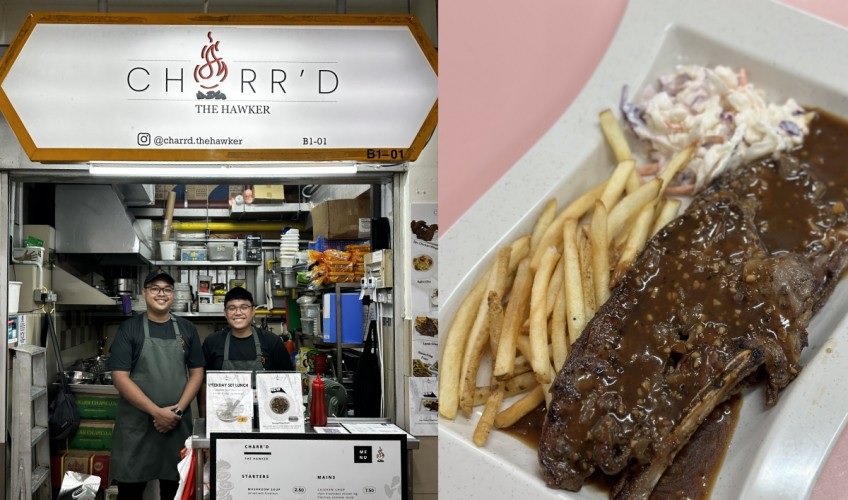Moving from the restaurant scene to work as a humble hawker can be a daunting experience for many chefs.
But Mohamed Amrizuhairi Bin Mohamed Amin, 29, and Fadzil Bin Mohd Alip, 27, took that leap of faith and chased their dreams.
And they’re not just working in someone else’s kitchen — the duo have set up their own hawker stall, called Charr’d, from scratch.
Having started operations on June 5, the stall is located at the bustling Golden Mile Food Centre.
Wanting to check the place out in the flesh, the team visited the stall recently to have a chat with Amri and Fadzil.
Looking smart in their chef’s aprons, the two young men told us more about how they are doing in this new, yet somewhat familiar, work environment. And, of course, we also got to try some of their beautifully charred meats.
It started off as a home-based business
The dream of having their own business together began all the way back when they were in university at The Culinary Institute of America under the Singapore Institute of Technology (SIT).
While they were still studying, they wanted to try their hand at running an F&B venture and started a home-based business called The Layered Brothers, which specialised in cakes like lapis rempah.
As they were still in school, they only sold their bakes during festive periods like Hari Raya.
But eventually, they realised that this wasn’t what they wanted to do in the kitchen.
“Because we’re actually trained in hot cooking, so like your usual Western, French, Italian – all these kinds of [cuisines],” Fadzil explained.
“So instead of doing pastries and cakes, which we are not exactly specialised at, [we thought] why not do something that we have been studying and working for instead?”
Therefore, they decided to pick up full-time jobs at notable restaurants — Amri worked at Le Jardin for around a year and a half, while Fazil worked at Piccante Pizzeria and Peperoni Pizzeria for two years.
While at their respective jobs, they still couldn’t let go of the dream to start their own business.
“We worked full-time for two years or so. Then we decided that with the experience and skills that we have, why not start something of our own,” Fadzil said.
So, they decided to quit their full-time positions — Amri last November and Fadzil last October — so they could open a hawker stall together.
Admittedly, they were a little anxious about doing so when they hadn’t gotten a stall in the first place.
In fact, Fadzil even worked part-time as a delivery rider to sustain himself during that period.
But they knew it was something that they had to do as they needed ample time and space to focus on the budding business.
$25k and lots of sacrifices
To set up the stall, the pair pumped in around $25,000 to $30,000, with the bulk of the money coming from their savings.
It also helped that prior to opening their business, they had a short stint during the Ramadan bazaar at Kampong Glam selling Western food, which gave them a little more capital.
Setting up the stall was just part of the challenge — the life of a hawker also forced them to change the way they work.
For instance, the men had to remember that they were not working in a restaurant, but rather in a fairly small hawker stall.
“We had to adapt from our usual restaurant-style service and operations and work as hawkers,” shared Fadzil.
“Because in a restaurant or a hotel, operations and the scale of it generally are a lot larger.”
To cite some examples, he explained how they can keep only a small inventory as the stall space was not big enough to accommodate the same amount of ingredients and resources as a restaurant’s kitchen.
There’s also much less room to move around in the hawker stall’s kitchen.
“You’re limited to whatever resources you can keep. You have to find a workaround,” said Fadzil.
Amri chimed in to add that the price point is another struggle.
“Based on all the ingredients we get, we can’t set the menu prices very high, unlike restaurants where you can charge one pax around $20 per plate,” he elaborated.
He added that working as a hawker can also be more “mentally and physically” challenging as compared to working at a restaurant because they don’t just do one specific task — they have to do everything.
“Here, you don’t just have to settle the menu, you actually have to deal with customers, you have to talk to them, you have to handle cash and money. You have to do everything on your own,” Fadzli explained.
The duo shared that they don’t get the same benefits that a company provides its staff with either.
“If you’re working under a company, you have employee benefits like annual leave, medical, and all that. Here, when you’re self-employed, there are sacrifices you have to make. But we are trying to work something out so that we can have similar benefits,” shared Fadzil.
Apart from all that, the two have had to sacrifice other things closer to their hearts, such as time with their loved ones.
“Most jobs are nine to five with Saturdays and Sundays off, but for us, we work every day except for Monday. And on Monday, others are working and we cannot really spend time with our family and friends,” Amri confessed.
Teamwork makes the dream work
So, how do they go about these hurdles? The duo revealed that the answer lies in teamwork and communication.
“For this hawker stall, it’s only the two of us. In a restaurant like where we used to work, it’s big. We have to give and take,” said Amri.
Fadzli added that things like transparency and having trust in one another are also crucial factors needed to make the partnership work.
“Because I rely on him and he relies on me. So it’s a two-way thing,” he said.
To also ensure that both parties get sufficient rest, they work different shifts on weekdays — Amri comes in at 10am in the morning and works till 4pm, while Fadzil comes in at 3.30pm and works till closing time.
“It’s a bit more efficient that way. If business is slow, we don’t waste manpower,” explained Fadzil.
Despite all these challenges, the duo still think that having their own hawker stall comes with good life lessons.
“I feel it’s a very good learning point for us. It’s a whole experience, starting a business,” shared Fadzil.
Get the lamb and chicken chops
The duo named their stall Charr’d because their meats are mostly finished over a charcoal grill to give them that beautiful char.
“So that’s where [we get] the smokiness, the colour, the aroma,” elaborated Fadzil.
Therefore, it would be a crime if I had gone all the way down to their stall and not try their grilled meats.
When I asked the duo what their personal favourite menu items were, Fadzil said his was the chicken chop ($7.50), while Amri said he preferred the lamb chop ($15).
And when pressed for a recommendation for an indecisive customer like myself, they recommended the same thing — chicken chop and lamb chop.
No brainer, I knew I had to get either one of these dishes and, boy, was it hard making a choice.
Eventually, I opted for the lamb because I feel that it’s a harder protein to cook and would be a good indication of the chef’s skillsets.
And I’m happy to report that it did not disappoint.
The dish came with two pieces of bone-in lamb as well as a side of french fries and homemade coleslaw.
They have several sauces available to choose from such as barbecue and mushroom, but the duo recommended I pair mine with black pepper sauce so I went with that.
I have to admit that I was a little nervous because I’ve had bad experiences with lamb before, such as the meat being too tough or having overpowering gamey flavours.
But as I took my first whiff of it and slid my knife into the flesh, all those concerns dissipated.
While the meat was thin – which makes it easy to overcook – it also was extremely tender and easy to cut through.
I was also surprised that the meat wasn’t as gamey as I had anticipated, and the smokiness from the charring did add a nice touch.
And the duo were right about the black pepper sauce. It added a nice, subtle spicy kick to the dish and really complemented the meat. I liked it so much that I used my fries to mop up the remaining sauce.




